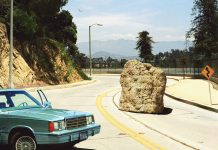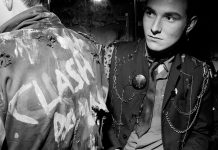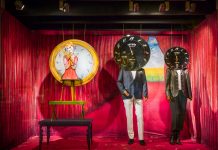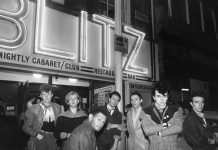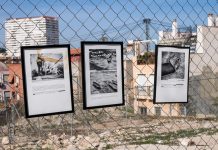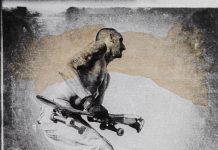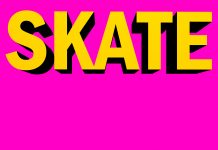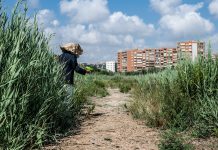
City Skate Tour #13 Alicante, 20 June 2021. Calle Fray Juan Rico. Alicante. Spain.
(1) City Skate Tour starts from a performative idea of urban space through a dissident sample of photographs, texts, photocopied, altered images, all of them belonging to the City 00Skate Days (CSKD) series. (2) To the extent that skateboarding seeks a new vital and social rhythm in the appropriation of the city and the search for alternative itineraries, the photographic exhibition can also become a differentiated urban practice, capable of creating visual thresholds far removed from uses and institutional submissions of art.
(3) The city is the nexus between image and skate. There is no claim in this. There is no other result than that which a passerby could attribute to you when encountering an unexpected image, an attribution of which any value or meaning is unknown. (4) But there are other ways of saying it: City Skate Tour proposes intervention in peripheral enclaves and restores the rhythm of a random, minimal world. That is why the influx of people in those specific spaces do not matter so much as the way in which the image becomes visible through the context that surrounds it. Skateboarding is a metaphor for that threshold.
(5) In City Skate Tour, the idea is projected into a basic action: crossing the city can be considered an imperceptible, inconsequential happening, but if at some point in the journey something causes the passer-by to stop, the action could also become a social fact. In this case, stopping is accompanied by other minimal acts: assembling the images to an urban surface has more to do with creating a site for the image than with a purely expository need.
(6) Between the action and the fact there is a whole compendium of social and artistic traditions that were going to try to show the city as something tangible associated with an altered, even revolutionary dynamic. The references are multiple, but what interested me is, above all, that the city can be used to express ideas, whether complex or simple. Ideas that become tangible in action. (7) The public expression of a work requires some type of social requirement, and this does not have to be restricted to the programmatic conventions of galleries or institutions.
(8) If the Situationists had shown another way of conceptualizing the urban experience based on a playful-constructive behavior, radicalized by their insistence on requesting for themselves a vital state that denied capitalist norms, I find in the gesture of the painter Peter Hobbs a current that unites art, nomadism and situationism. The art critic Thomas Crow would express it as an emerging art form that moved away from any foreseeable gaze: «Peter Hobbs led the situationist aesthetic towards a process of isolated nomadism», and he did so by hosting his canvases on vacant lots in the East End of London to photograph them later as an indirect, but more vivid and real, way of recreating the painting in an urban installation. War photographer Don McCullin helped him create that sensation through photographs that were to fix the fact, that moment, on the margins of institutional life.



Fotocopia #114. Performers. 2017-2020. Texto. Public perception has posited skateboarders, street performers (breakdancers, graffiti artists), and other subcultural populations (homeless, youth) as possessing no economic worth and as inadequate consumers of public space. However, the postmodern ethos of skateboarding in the 21stcentury has led to the emergence of the subcultural identity as an increasingly important output of capitalistic production processes through the production of marketable street imagery and cultural creativity. Now that skateboarding has global reach, this has presented new sets of planning problems for local governments and city planners. While city governments celebrate the benefits of recreational risk-taking, they continue to exert control and prioritize commercial interests. For example, there is legislation enacted in various countries worldwide to keep skateboarders out of city centers and to fine skateboarding in public places, while many skateboarders who are provided publicly-controlled skate-parks still transgress boundaries to retain subcultural identity [while remaining] deeply skeptical of skateboarding being represented as a sport. Referencia. Christopher D. Giamarino. Spatial ethno-geographies of sub-cultures in urban space: skateboarders, appropriative performance, and spatial exclusion in Los Angeles, 2017.
Fotocopia #115. Expanding the possibilities. 2016-2019. Texto. Skateboarding is a way of expanding the possibilities of a city’s architecture, challenging conventions, remodeling public space and creating another Dasein at the heart of ideology’s ground. But skateparks produce skaters that are more identical, embarking on the single path of organized sport. Skateboarding’s natural habitat is the urban habitat, though it is realized by creating possibilities that were not intended by ideology’s ratio (Borden, 2001), for instance jumping off of a set of stairs while flipping the skateboard. Or as the pool (i.e. bowl) riding era has shown, skaters have been able to reinvent things that were produced out of ideology and subsequently whittled away to give them a different concrete meaning. Skateboarding would be impossible in a purely given state of nature since it needs man-made surfaces to exist: streets, curbs, rails, ramps, sets of stairs, walls, intended voids, etc. A common ground, literally, insures the contradiction of skateboarding with ideology, because there is no contradiction where opposing things are indifferent to each other: skateboarding has freed ideology’s ground from pure identification. But with the concrete trespassing of skaters onto ideology’s ground, ideology was compelled to react. Referencia. Antoine Cantin-Brault. The Reification of Skateboarding, International Journal of Science Culture and Sport, March 2015.



